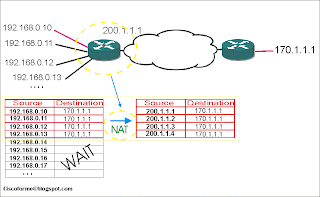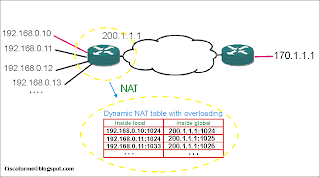(Wan Speed : From 2400bps to 45Mbps(T3))
DTE = Data Terminal Equepment
DCE = Data Communication Equepment
Remember these notes about Frame Relay :
- Frame Relay is a popular WAN protocol that today is instead with VPN and Multi Protocol Lable Switching (MPLS)
- Frame Relay Task is deliver layer 3 packets between routers.
- Leased line provides a WAN service between tow points . each router with CSU/DSU on end of this link and installing two-pair(four wire) cable into the building . a dedicated line . if you need more than one link you should order a new link with new devices on end of new link . but in Frame Relay you could have more than one links and WAN services between some points without buy more than one link or buy new devices . in other words Frame Relay is a point-to-point , point-to-multi point and Muti point-to-Multi point wan service with cost advantages than leased line actually Frame Relay can send data to multiple remote routers over a single Physical WAN circuit .
- HDLC , PPP and Frame Relay can use same physical Layer specification but ISDN has different pin out and specification at physical layer .but remember that ISDN is an infrastructure that any of PPP , HDLC and Frame Relay is working on it . PPP is a most common encapsulation across ISDN connections.
- ISDN can work with both asynchronous and synchronous serila links but Packet Switched service (Such as Frame Relay )only work with synchronous.
- Frame Relay is a NBMA(none broadcast multi access ) network. because Frame Relay use an identified addresses for each router .
- In fram-relay there are some useful notification such as FECN (Forward Explicate Congestion Notification) & BECN (Backward Explicate Congestion Notification) or DE (Discard Eligibility). if any problem occurred in frame-relay switch or any congestion frame relay send a FECN or BECN notification with a FECN=1 or BECN=1. FECN for a congestion in fram-relay switches near you and BECN for a congestion on the othe hand .
- FECN and BECN equal zero if there is noo any congestion occurred.
- DLCI (Data Link Connection Identifier) : identifies the VC for each link . remember that each router that connect to Frame-Relay has a specified DLCI.DLCI must be unique for each VC. so same DLCI is used on every access-link.
- Global DLCI : global addressing for DLCI just makes DLCI assignment more obvious.remember that each DLCI is unique.
- VC (Virtual Circuit) : Define a logical path between 2 Frame Relay DTEs.that is virtual path shows the connection between your two DTE devices
- VC categorized in two mode:
- PVC ( Permanent VC ) :They are working as long as you pay bill.
- SVC (Switched VC ) : Work like a phone call when you use .work when need data transfer and take down when data transfer is complate .
- LMI : is a defination messages that travel between DTE ( your Router) and DCE (Nearest Frame Relay switch) and have a messages containing status of links :
1- LMI peform Keepalive messages . 2-the signal weather a PVC is active or inactive . - after a router recives LMI from Frame Relay switches can update the virtual circuits status to 3 diffrent status : 1- Active state 2- inactive state 3- deleted state

- LMI protocols are : cisco , ITU , ANSI
- LMI types are : cisco , q933a , ansi
- A router that is connected to Frame-Realy befor send each packet encapsulate it in a Frame-Relay with defination header and trailer and then send out it on Access-Link .
- Subneting on Frame Relay :
- one subnet containing Frame Relay
- One subnet per VC
- A hybrid of two previous option .
- If you use different router on end of WAN link you should use any of PPP or Frame-Relay encapsulation . by defalt HDLC is runing on Cisco routers.that not recognized for the other brands.
- Frame Relay provides Packet switched network to many diffrent costomers at the same time .
- Two separet bandwith specifics wiyh Frame Relay :
- Access Rate : The maximum speed that Frame Relay can transmit
- CIR : the maximum bandwith of data guaranteed to be delivered.actually is a rate in bits per second at which the Frame Relay switch agrees to transfer data.
- You cant use PPP and HDLC on Frame Relay because Frame RElay is basically diffrent from the others .
- Frame Relay Encapsulation :
- CISCO : for two cisco Devices
- IETF (Internet Engineering Task Force ) : between two different device .
- There are some different end for serial connection between DTE and DCE :
- EIA/TIA-232
- EIA/TIA-449
- V.35(Connect to CSU/DSU)
- X.21(used in X.25)
- EIA-530
- Planing for Frame Relay :
- Which physical sites need to Frame Relay
- Define each VC by identifying the end points and setting the CIR
- Agree to an LMI type (Usually dedicated by provider )
- define Subneting
- Frame Relay Mappnig : Mapping between layer 3 address and its corresponding layer 2 address similar ARP cash for LAN .Mappnig is needed for multicast network .
- Inverse Arp : mapping between layer 3 address(IP) to layer 2 address (DLCI). it is disable on router when you configured router with #frame-relay map command .
- when you use static map remember that other router on end of the VC will not recive any Inverse ARP messages and may also then need to be configurd with #frame-relay map command.
- Frame Relay command :
- #encapsulation fram-relay {cisco/IETF}
- #frame-relay lmi-type {ansi / cisco/ q933a)
- #fram-relay interface-dlci 16(or any number between 16 to ?) ietf
- #show frame-relay pvc
- #no keepalive
Some Notes about ISDN:
- Carry voice ,video and data .
- Call setup is faster than modem.
- Data rate is faster than modem
- Fuul time conectivity across the ISDN is do by the cisco IOS routers using dial-on-demand routing (DDR)
- ISDN can be used as a backup service for leasedline conection.
- PPP is the most common encapsulation across ISDN connection.
1. #interface serail 0/0
2. #encapsulation frame-relay {cisco / ietf} for all vc
3. or #encapsulation frame-relay interface DLCI ietf (for single subinterface)
4. #fram-relay interface-dlci ietf
5. #frame-relay map ip ip-address dlci
OSI layer Protocols :
- Layer 1 : IP , IPX , Apple talk
- Layer 2 : PPP , HDLC , FRAME-RELAY , NCP , LCP
- Layer 3 : V.24 , V.35 , ISDN








